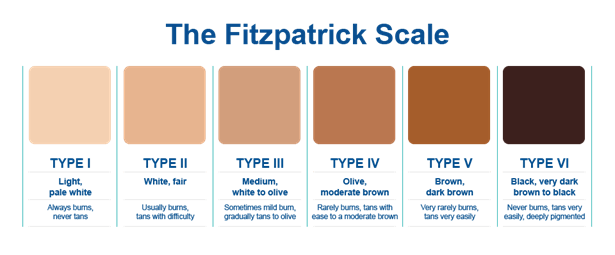Published on May 1, 2018
Does your skin type determine how much sun is healthy for you? Is sun exposure individualized?
Yes! Sun exposure is very individualized. In order to get sensible sun exposure you need to take into account:
- Your skin type
- The current UV strength (depends on time of day, location, season)
- Duration
This article will focus on skin type. Why? Because if you read government regulations, do a quick Google search, or ask a dermatologist – most will say the same thing – apply sunscreen before you go outside and if you do get sun exposure it should be no longer than 15 minutes midday.
“Unprotected skin can be damaged by the sun’s UV rays in as
little as 15 minutes.” – CDC web site
“Whatever our skin color, we’re all potentially susceptible to sunburn and
other harmful effects of exposure to UV radiation.” – FDA web site
15 minutes?
Yes, that is what you hear often. It’s just not that simple. Fifteen minutes is too short for many and too long for others. There are 6 different Fitzpatrick skin types, each can withstand different amounts of sun before burning. Please take a moment to review these types. Once you have identified your skin type, you can then use tools such as the free app, dminder, to approximate how much time you can spend in the sun without burning. dminder uses EPA burn data, your self-input skin type, your location and current UV index to approximate when burning might occur and give you an alarm before that time.

Credit www.perfectimage-llc.com
Why does skin type matter?
The darker your skin, the more melanin it contains. Dr. Michael Holick calls melanin your body’s natural sunscreen. Melanin in your skin is genetic, but it can also increase through gradual, sensible sun exposure. (This is explained in minutes 7:20 – 10:30 of Holick’s presentation Sunlight and Your Health: An EnLIGHTening Perspective).
According to the 2008 paper by Brenner and Hearing, The Protective Role of Melanin Against UV Damage in Human Skin, individuals with fair skin are 70 times more likely to get skin cancer than individuals with very dark brown skin. It also explains that melanin could provide up to a 4 sun protection factor (SPF) and explains that fair skin allows 3 to 4 times more UVB and UVA, respectively, to pass through the epidermis to deeper layers of the skin than very dark brown skin.
Acclimation
Acclimation is also very important, as explained above with the increase of melanin. Based on recent sun exposure, two people of the same skin type could be in the same location for the same amount of time and one would burn and the other wouldn’t, simply because one had already become acclimatized to sun exposure and the other hadn’t.
We recommend starting sun exposure very gradually. The Rollier method described below exposes only the feet for 5 minutes at solar noon on Day 1 of acclimation. Day 2 your feet are exposed for 5 minutes and then your feet and shins for an additional 5 minutes. Continue gradual exposure for a whole week. Even without these exact limitations on exposure area and time, the general idea of slowly allowing skin to be exposed for increasing amounts of time over a period of several days is recommended.

What does this mean for you?
- Figure out your skin type.
- Acclimate yourself to the sun gradually this season – start slow.
- Use apps such as dminder to help remind you when to get out of the sun or cover up – you want exposure without burning.

